“Business was bad? Fuck you, pay me.
-Henry Hill (Ray Liotta) Goodfellas [1990] (Director: Martin Scorsese, Warner Bros. Pictures)
Oh, you had a fire? Fuck you, pay me.
Place got hit by lightning, huh? Fuck you, pay me.”
Introduction
As I venture out into the world of self practice, the reality of running a business has been smacked across my face several times. Getting contracts together, client management, and numerous other aspects beyond what I thought being an Architect was ‘all about’. The worst and most recent slap in the face was a client who refused to pay their invoice.
I knew it would happen eventually, and deep down a part of me was happy it happened so early into my career. The opportunity to learn how to navigate this issue for a small amount of money will pay dividends going forward in my career.
This is our story about a client who would not pay the agreed upon amount. Our struggles with the process, how we got them to pay us our money in full through claims court, and the lessons learned for next time. We run a husband and wife studio, and the amount owed to us was $3,500.
(Disclaimers: I am not a lawyer, and not your lawyer. None of this is legal advice. Names such as hotel, clients, and all other identifying measures have been altered or changed for privacy. Any resemblance to actual places, persons, living or dead, is purely coincidental.)
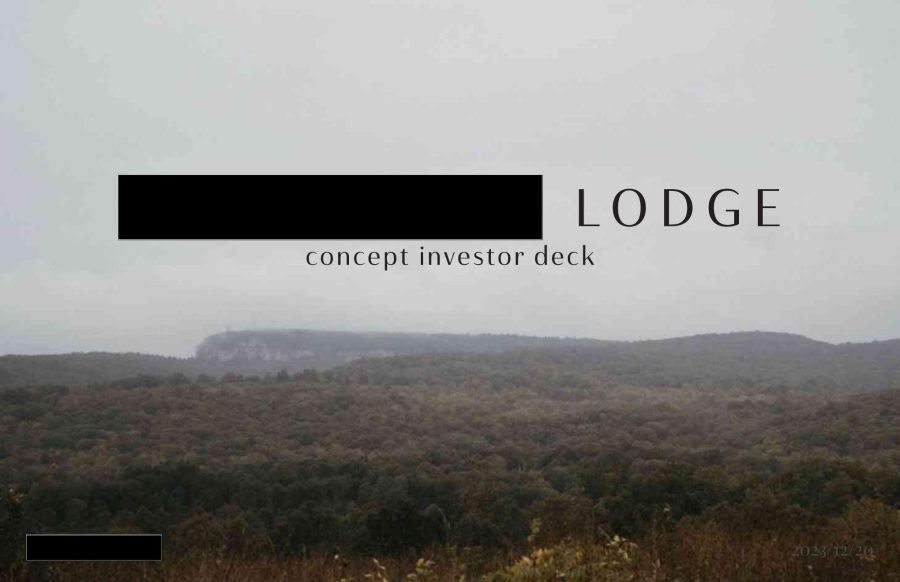
Overview
- Part 1 – The Client & Project Story:
- Client: Who they are
- Project: Project Scope
- Schedule & Proposal: What we said we would do for what
- Scope Change: Why we charged money
- Presentation Work: Brief overview
- Payment Issue: When they wouldn’t pay
- Part 2 – Small Claims Court
- Commercial Small Claims Court
- Sending Notice
- The Notice Letter
- Court Date
- Small Claims
- Court Document Preparation
- Court Date
- Court Hearing
- Part 3 – Hindsight 20/20
- Warning Signs
- Part 4 – Conclusion
- Their “Renovations”
- Final Thoughts
Part 1 – The Client & Project Story
Throughout the story you will see superscript numbers like this(NOTE 1). These will connect to Part 3, Hindsight 20/20 and the lessons learned from those pieces of the story. We recommend reading the story all the way through, then referencing back while reading part 3.
Client
The client that came to us was the general manager for a small ~20 room hotel. Located near our office in The Hudson Valley of New York, we immediately were tickled at the thought of having a hotel we helped work on in our backyard. We founded our company knowing two things, that we wanted to work in the Hudson Valley area of New York, which is why we relocated to this area several years ago. And secondly, that our primary bread and butter would be hospitality focused designs, specifically resorts, hotels, or vacation homes. This project on the surface seemed like a perfect stepping stone(NOTE 1) into the region, small enough we could handle ourselves, and large enough that it should have a good budget.
The Hotel, “The Shawangunk Lodge”, abbreviated hereafter as, The Gunks Lodge, was recently purchased by an investment group(NOTE 2). The general manager, Alec, reached out to us as a very brief and former contact from another job. He was recently hired as a live on site caretaker and the general manager of the hotel. In his words, he was hired, ‘to completely run and change the place and fix its numerous problems’. As the current owners, according to Alec, “have no idea what they are doing”. Alec postured himself as a part-owner, with complete control over the funds and also all of the decision making power(NOTE 3). Throughout our walk throughs, he stated multiple times that the other owners have empowered him and, “will do whatever I say to do”.
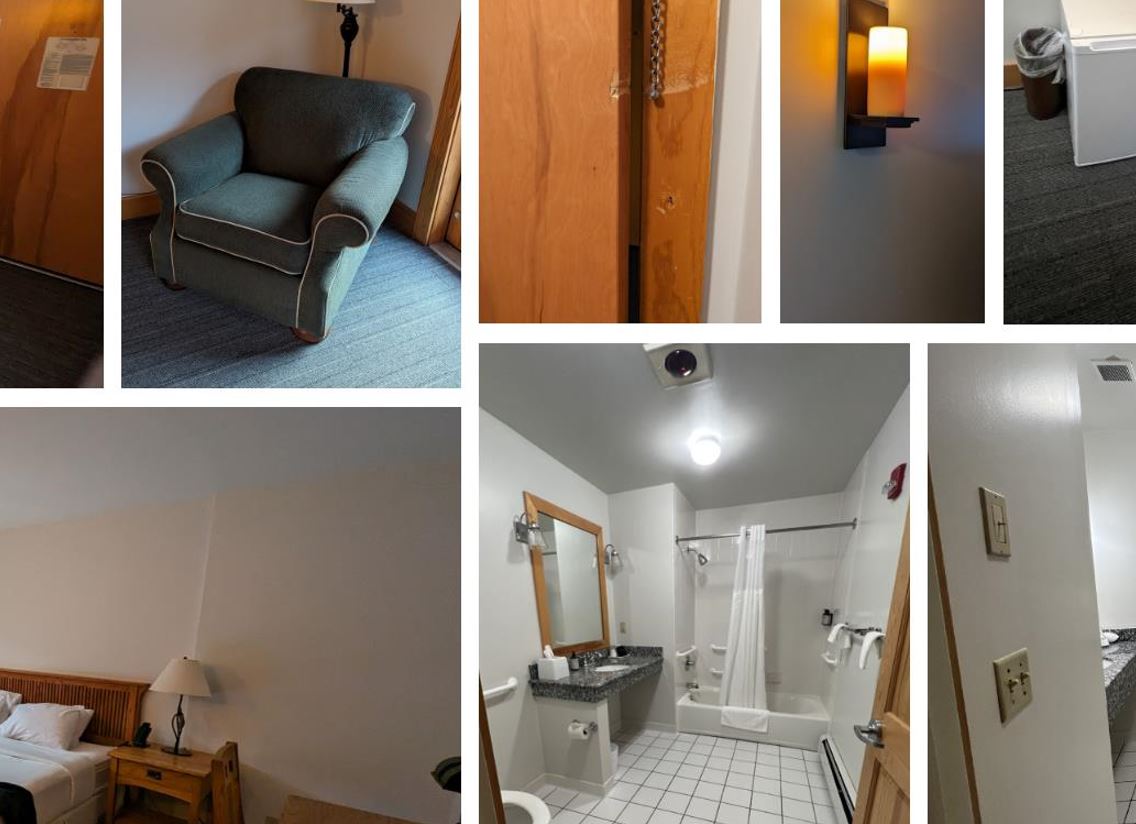
Project
The Gunks Lodge has serious issues. The previous owners were locals who ran it very lackadaisical. 20 years old, the Lodge was beyond showing this neglect and looked twice its age. Poor patching of leaks, outdated furniture, clashing interior palettes, major exterior issues, and numerous other minor issues. As an example, furniture in the hotel rooms such as side chairs and tables were all mismatched, and best we could tell, came from the owners private home once they were done with them; or perhaps a flea market deal. The current investor group purchased the Lodge in 2023, and were now looking to upgrade.
The biggest issue far and away was sound. The original building was a lodge designed by a local architect, who seemingly had minimal knowledge in soundproofing. If you look at the reviews on Google, many times you will see the issues we experienced firsthand. While in the rooms, you could easily hear someone from the room next to you at normal speaking volumes. It was as if they were in the room with you. And the issue persisted from the hallway to the rooms as well.

The layout of the hotel itself was confusing and amenities additionally limited. Access for workers was behind the back and the best/biggest unit in the building was a suite which was located in the basement next to the worker entrance. The suite in particular was meant to be an upgrade, but was much more like a downgrade. The layout of additional spaces was confusing and underutilized as a huge basement existed with zero amenity spaces. In short, the hotel was far behind the times. As in the rule of real estate, location location location. The one thing the hotel had for it was its great location adjacent to hiking trails and great view of the Shawangunk mountain range.
Schedule & Proposal
Alec asked for our help. He needed to know how much it would cost for us to do this work — and there was a lot of work(NOTE 4). It was quite a hard thing to request… the scope entailed immediate fixes they wanted done within 6 months, along with multi-year master plan work. As is industry standard, we said we could prepare a fee proposal that would detail what we could do and schedules etc. This free proposal was purely going to be what amounted to an excel sheet and calendar – absolutely no design work. Based on the need to first understand the scope of the Lodge and figure out a clean way to break down the phasing, we agreed to have about 30 days to put this proposal together. Late December deadline to hit the ground running in the new year from comments and hopefully an official hire.
Scope Change
A couple days after our initial agreement, on December 4th, Alec requested we pivot. He now asked how much it would cost to create a design proposal to take to his partners about changes that we envisioned dealing with all these issues. This had a very tight schedule for deliverable 16 days from this request. This new presentation we discussed with him was clear that it needed to be an overall design visioning document, with potential for also some multi-year projects such as exterior landscape, suite work, etc. Unlike industry standards, we were explicitly clear that we would not do any design work for free, regardless of what the document entailed— we needed to be paid for our design work, and it would cost money. Alec agreed with this, he stated he didn’t want us to do work for free, so he agreed to our fee.
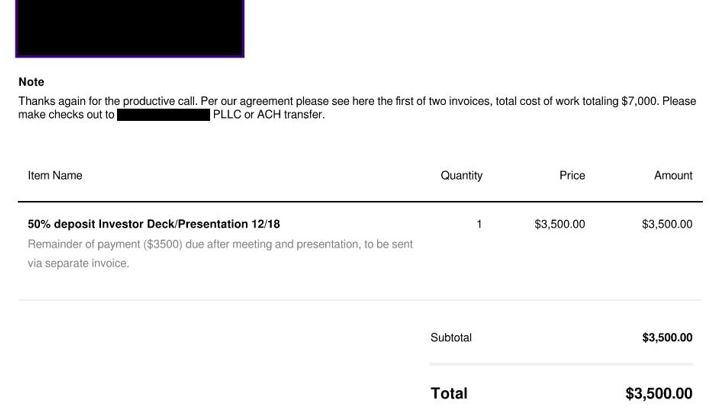
This December 4th request had a December 20th deadline. A silly short schedule that required us to drop all other client work and pivot gears. Our fee was calculated to be at $7,000 for this work. 50% was due immediately for kickoff and the other 50% once the presentation was delivered to the investor group. This was verbally agreed upon in a meeting, and we immediately sent over our first invoice which memorialized the fee terms and contract(NOTE 5) .
The 50% deposit was paid immediately(NOTE 6) (same day) and we hit the ground running. 2 Days later I was on site taking measurements, site survey of conditions, and working in general to understand more about the lay of the land and hotel functions. While on site, we were told by one of the front desk workers, ‘oh do you work for that company that came through here?’. Alec remarked that there was another designer(NOTE 7) who came through a month earlier staying at the hotel and randomly was trying to get the work, but that he liked us better and was going to go with us. Weird.
Presentation Work
Over the next 2 weeks, we worked countless hours creating work that was all custom to the project. During this time we were in frequent contact with Alec and tried to learn more about him(NOTE 8), his design inspiration, a new paint color he was doing to the innkeeper house(NOTE 10), and his own personal AirBnB.

The investor deck was a 70 page design document that took almost 2 hours to present to the clientele group. The presentation included mood boards, existing conditions documentation based off site survey walkthroughs, architectural details, new suite layouts, amenity proposals, and even an estimated budget and masterplan pieces.
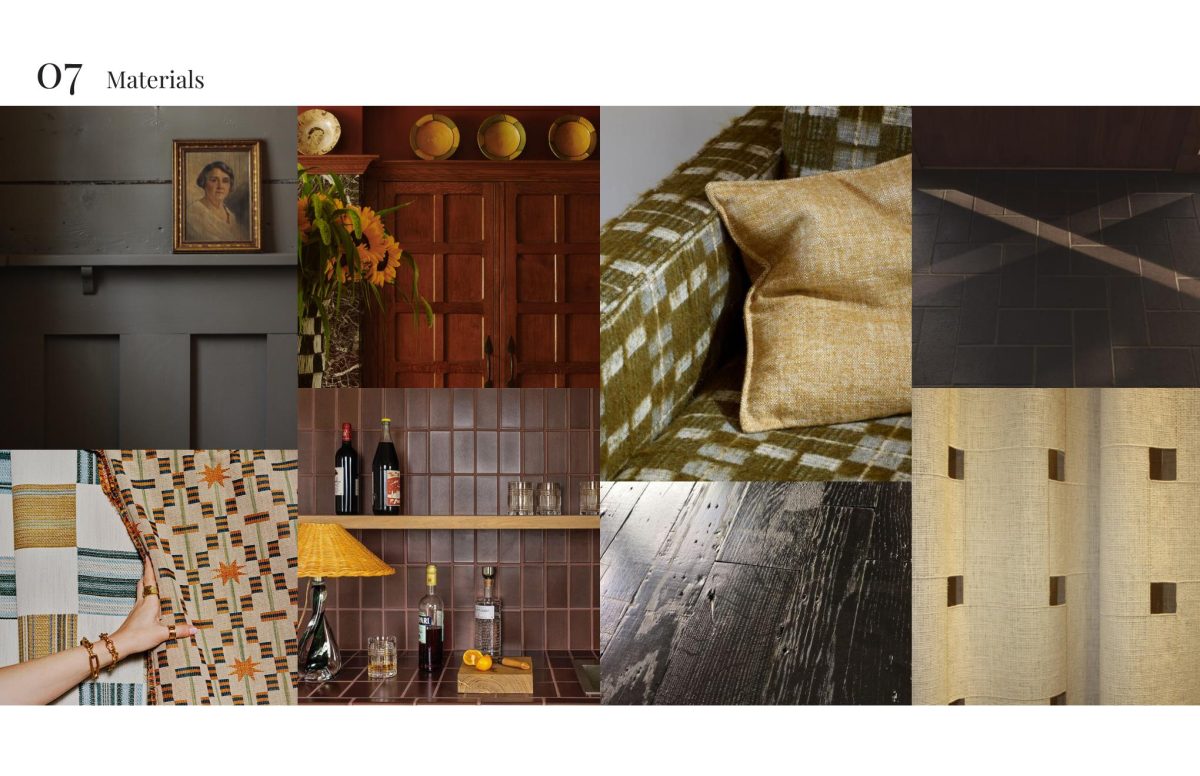
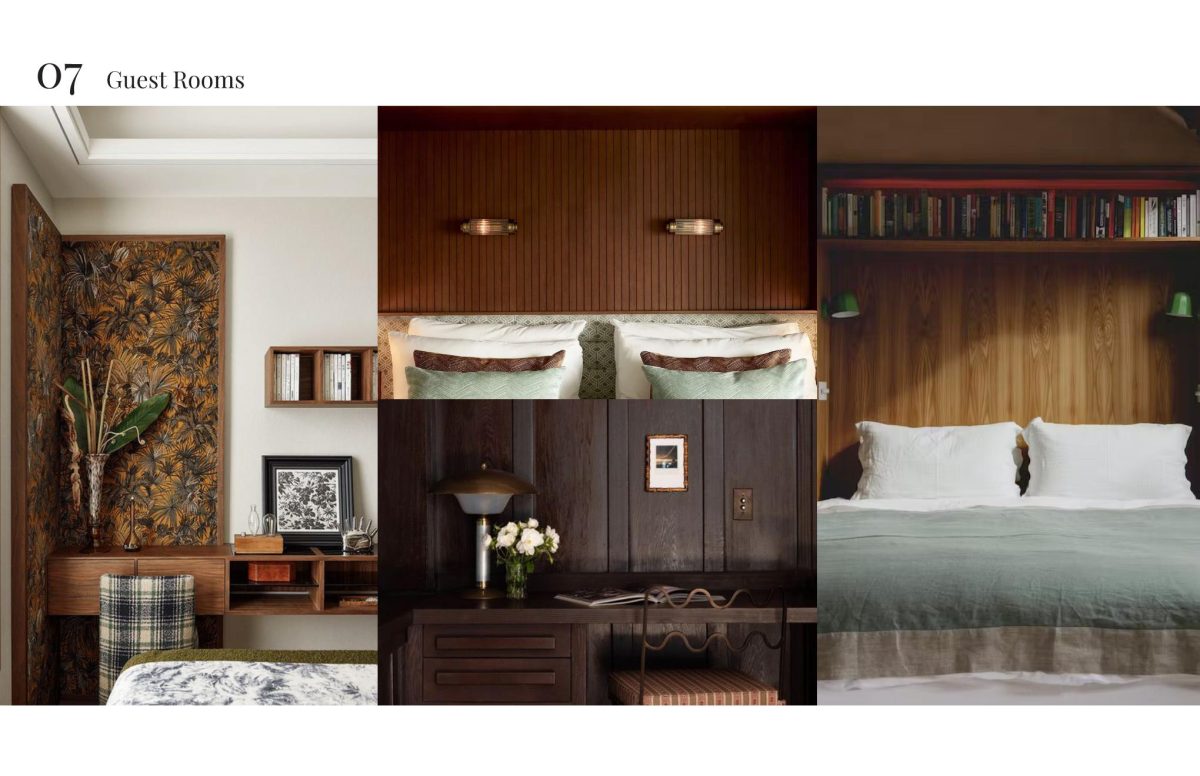
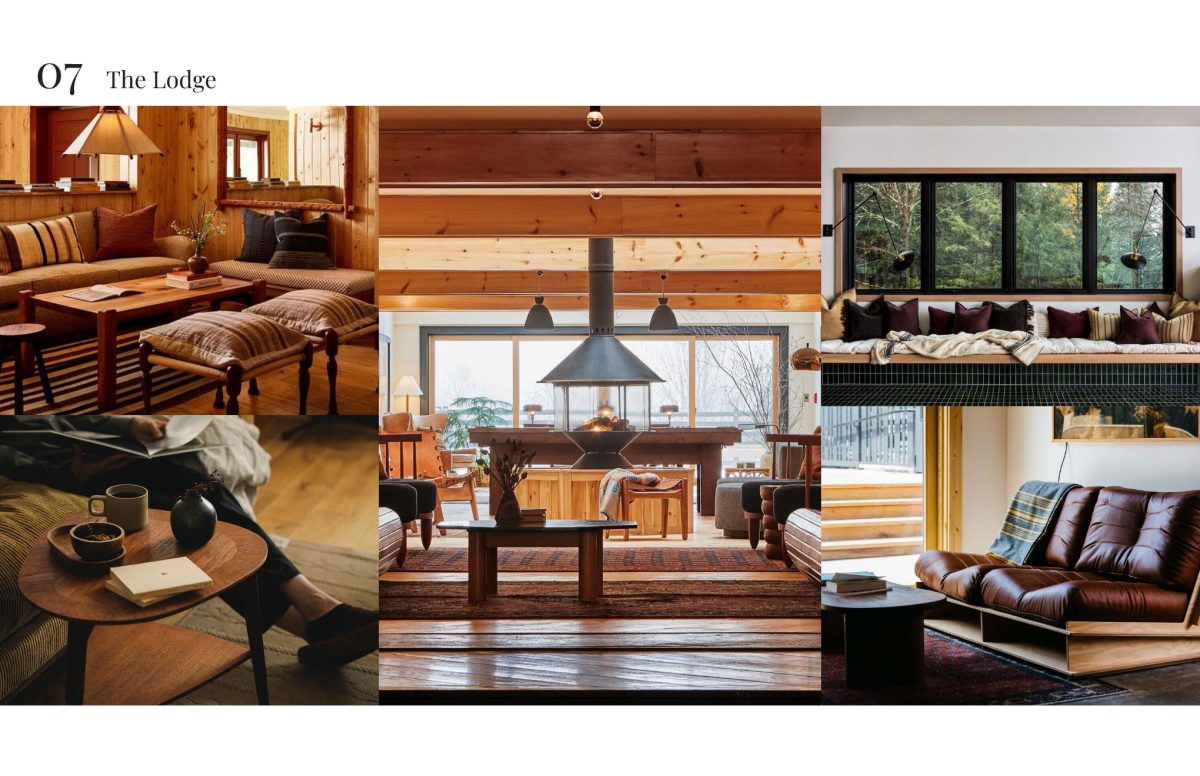
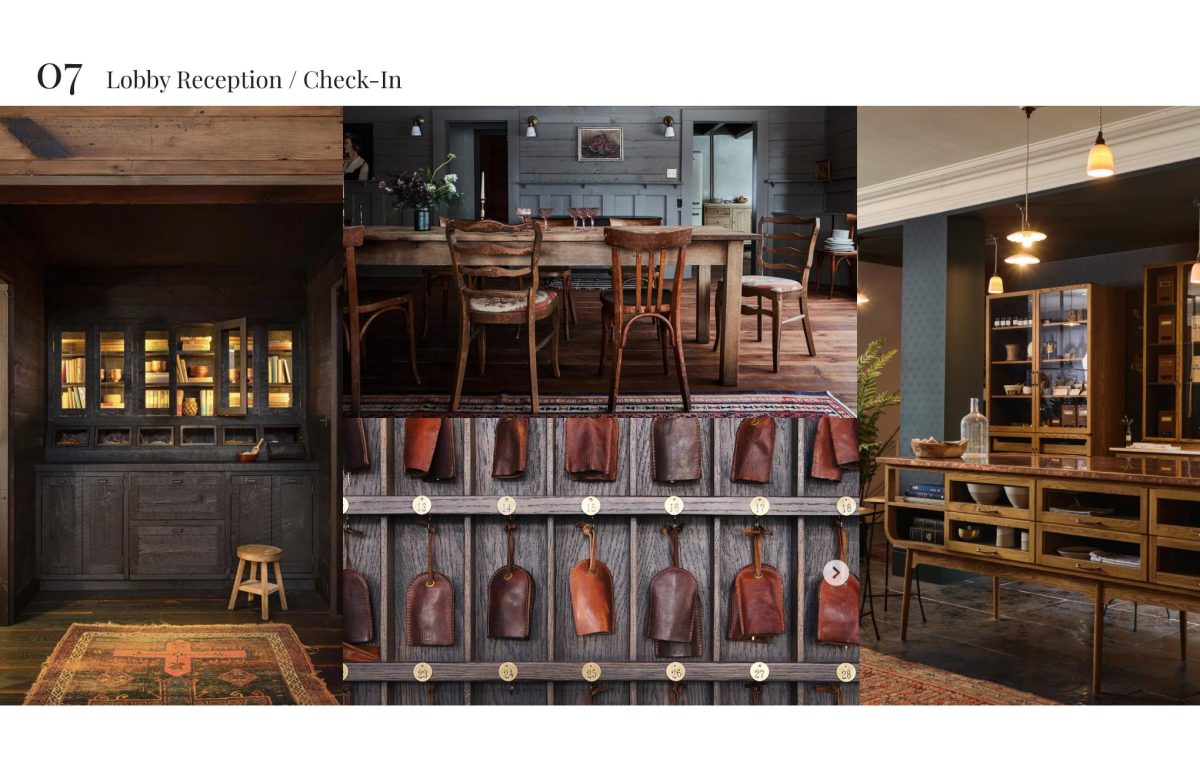
The presentation deck is subjectively well put together. We reviewed it several times with peers, and for such a short time we were able to pull together comps, research issues with the hotel from the public, mood boards, overall design direction, plenty of options for the investor group to think about along with numerous other aspects. In attendance for the video call was Alec, as well as Owners Morgan and Henry. PDF deliverables along with the final invoice were sent over on the 22nd, when we gave the presentation(NOTE 11).
Payment Issue
During the holidays, we figured we wouldn’t hear much. Everyone celebrates their own way and we wanted to give them time and space to digest the big presentation. However, we did reach out right before the break to see if we could get any sort of feedback to start chewing on while we were on break. The text response we got back was, “they said they were not particularly impressed.”…”for less money and time the other designer(NOTE 12) had a full room look and common area look and materials etc.”
We knew payment would be an issue after that text. It’s fine if someone doesn’t like the work we produced, its happened to us many times before and will happen again— however, this was one of the most unprofessional reactions we’ve ever received. In the new year, we reached out to Alec several times to inquire what the status on the money was. Essentially Alec stated that they were not going to pay, as they felt the deliverables were not yet met.(NOTE 13)
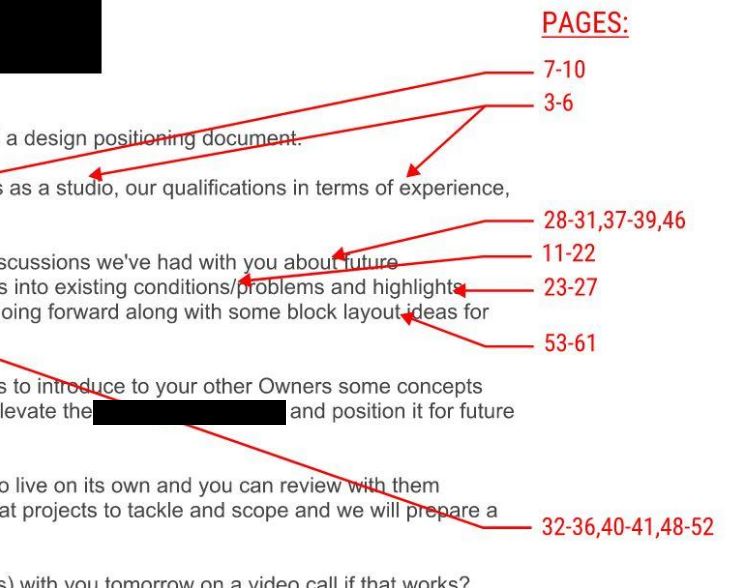
Part 2 – Small Claims Court
Commercial Small Claims Court
After imploring them to do the right thing and pay us the agreed upon money, and nothing but silence from them after awhile, we had no choice but to pursue legal action. It wasn’t until we put the owners of the company on a notice email that we finally received a message from Alec back — essentially making excuses, but if you read between the lines, it was stating he would not pay.
As we are a PLLC, we were able to use the commercial small claims court process in NY State. A couple of differences in commercial vs private:
- Case is through a city court, not a town court. These are larger, but there are less of them.
- It’s you as a business rather than a private party.
- Limits that you can sue for are higher. The limits change based on where you are and what courts you go to. Our limit was $5k in our city court, and that seemed to be pretty accurate for most, except for larger cities like NYC where it seems to be $10k or more. For example it seems California has higher limits.
If you are simply a freelancer or moonlighting, I believe your path forward would be ‘normal’ small claims court. This is the same process if you were a homeowner who hired someone to do housework and they never showed up or didn’t finish the job.
Another lesson we learned — which is kind of a bummer — is that the court taking the case needs to be in the location of the business that you are suing. This is important to know in the case of working for someone a couple hours away, it would be more difficult to go to the hearing and be more of a nuisance for yourself with travel — another reason to try and work local to where you live.
- If you do take work multiple hours away from where you live, make sure you account for this in your fee and contracts and protect yourself accordingly.

Contracts
I’m sure you have an idea of what I am saying when I write ‘contract’. However, it doesn’t have to be that long AIA contract in order to have a case. A contract can take many forms (written or oral for example) and doesn’t have to be even a signed document. The legal definition of a contract needs to have 4 parts to it. You can read up more on other sites (not what this site or post is about), but basically per our understanding…
- Offer and acceptance: I will do this presentation for you, it will be $7,000
- Consideration: Both parties receive or exchange something of value (goods, services, etc)
- Capacity: Both parties have ability to enter the contract legally (can’t legally hire someone to do work on a property you don’t own, and someone can’t hire you to do work for a business they don’t have the authority to do).
- Legality: Contract itself is legal (a contract for killing is illegal and not a real contract)
When going to small claims, the hardest part that you are going to encounter is proving that you have met those 4 parts, specifically the first part of offer and acceptance is hardest when you are trying to rely on something like a verbal contract. Always get everything in writing.
If you remember earlier, we did not have a formal contract, but instead wrote our terms into the invoice. While our client Alec did not sign anything agreeing to pay the full amount, but he did pay the first invoice which clearly stated the terms. This payment was made from a Lodge bank account. His first payment to the invoice means that he was aware of the offer and accepted (part 1), both parties were receiving something (design services for money – part 2), he represented himself as the decision maker in every conversation and proved he had access to the Lodge funds by paying us from that account (part 3), and of course everything was legal that we were doing in all aspects (part 4). We felt we had a great case for getting our money.
Sending Notice
One of the most important pieces to bring on the claim is to give notice to an individual before the claim can be filed. You will see this in the requirements to file with your court that you need to provide proof of notice. Many states have boilerplate notices that you can use, however we crafted our own. It needs to be explicit in the amount, what for, etc. You also need to send via certified mail (or another trackable way as far as we understand) to verify that it was received by the business. We decided to use an online service – DocuPost. This process isn’t as serious as someone getting, ‘served’ in the movies… but it’s a similar aspect. The best part of this is you establish a deadline of a date that is the ‘we are filing at the courts on this date if you do not pay’.
One thing you should make sure to do is be reasonable with time. For example, while our funds were due upon receiving as soon as we sent the invoice, we were extremely lenient and gave them a full 60 days before we were going to claims court.
Our Timeline
- Dec 20th – 2nd Invoice sent for remainder $3500 due immediately
- January 29th – Judicial intervention notice (DocuPost)
- Feb 20th – Last day to pay us (stated in Jan 29th letter), we will file in court the next day
- Feb 21st – Our court filing (mailing) date.
The Letter is… (Normally) Enough
In speaking with an attorney friend, he stated that the letter is normally enough to let people know, you essentially aren’t going away — and you need your money. And there are real consequences if they do not pay up. Especially in ironclad cases, they will typically pay up to avoid the court process, avoid any negative publicity, and just get you out of your hair.
For us, it partially worked. After receiving the letter, Alec decided to give us $2500 of the $3500 ($1,000 short). We filed (mailed) the $3500 claim to the court on February 21st. We received the $2500 payment on the 22nd. I have no idea why he would wait until after the date we gave, but we still would have filed anyway for the $1,000 — so it did not matter to us.
After receiving the funds, we decided to do nothing at this point in time. We weren’t sure if Alec was mistaken and thought he paid us the full amount, or if this was an attempt to pay as little as possible, thinking that we wouldn’t go after the final $1,000 in court. I assumed the latter as I’m sure a website somewhere suggests this scummy tactic.
As a note, we did call the court to see if there was a document or process to change the notice prior to our court date – they stated “no need”. That we could simply let the judge/arbitrator know on our actual date to lower the amount from $3,500 to $1,000.
Court Scheduled
About 2 weeks later around March 10th, we received a letter for a court date of April 22nd at 9am. This was earlier than we were expecting. Having a friend who went through this process on Long Island, their court date was scheduled 3+ months out. I suppose it just matters with how busy the court is.
The court letter makes it real. As someone who just wants to run a design business and doesn’t really want to rock the boat or get into all this junk, it was a bit nerve wracking. I was uncomfortable… and at this point felt it was good business development and learning for myself as an owner to push myself to go through the process. Even though it was only $1,000 — I would have done it for even $100 at this point in time.
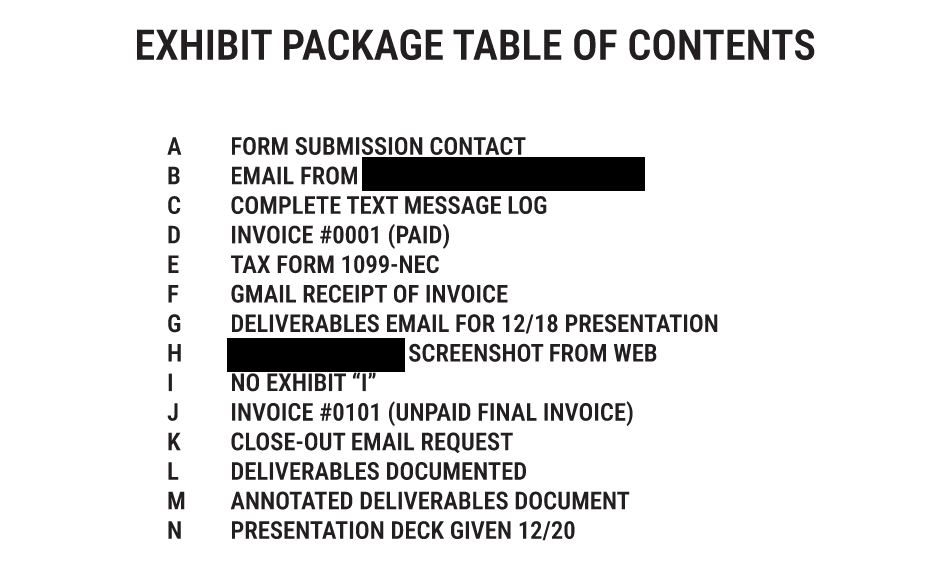
Court Document & Preparation
We are Architects, we like to over prepare. I therefore spent time over preparing two long documents that were my best attempt at what I think lawyers would do. One of the documents was a timeline of the events, with embedded screenshots and snips of messages etc, to help illustrate the story. This document was broken down into two sections, a short synopsis (2 pages long) that I could read within 1-2 minutes to give the judge an overview. The next was 9 pages long, detailed where it goes into each item specifically without missing out anything. The document in total with title pages and ending page was 15 pages long.
The other document was my ‘exhibits’. This was 30 pages long. Each item I wanted to share/reference was marked as an exhibit so I could reference it in the detailed document and track everything. This included painstakingly screenshotting the entire text message thread and putting that into a document, along with the entire presentation so that I could reference the pages if anything came up. This included my close out request emails, text messages, presentations, including even screenshots of the owners webpage showing they owned the property, since I named them as the defendant.
The theory I took here, is that I wanted to have an argument for any single excuse Alec or whoever showed up could or would make. I was ready and even practiced rebuttals, and in general, made sure I was not going to lose.
Court Date
Well the court date came. The most annoying thing is making time in your normal work schedule and meetings for it. If the amount you are going after isn’t a lot, it may not be worth your time. I from a principled standpoint think everyone deserves to be paid for work, and therefore, I was going to invest my time to recoup as much money as I could.
I showed up at court at 8:50am – Give yourself time to go through security and in case there is a line. There was someone to check in with so that they could mark on the court docket that you have ‘arrived’ with your time. The court itself is basically no talking, no cell phones, etc. It’s boring, bring a book; or in my case print out your document so that you can re-read it and make sure you know where things are located in the documentation/evidence.
Court opened up at 9am and was quite interesting. Public can of course go to these courts and sit to observe, but it was mostly petty crime issues and seemed to be no public there. Some were traffic violations, and other more serious ones were domestic abuse cases with defendants sometimes coming to/from the jail. During this whole time I was a bit intimidated by the process. There were public defenders and attorneys — and all the real life lawyers doing lawyer stuff.
Small Claims
Around 9:15 I saw a security officer come out a back room from the court and escort two different parties into a room, a middle aged man and a couple. They were in the room for about 15 minutes, then one of the parties came out for 5 minutes, while then the other party came out and the others went in – all with the security guard helping facilitate this process. This was the small claims court process. This was someone who was bringing a claim against another person. At the beginning both parties were in together and brought their evidence/claim. And then the judge/arbitrator spoke to each individually, then back again together at the end. The whole process for this particular claim (no idea what it was about) seemed to be about 60 minutes.
All during this time I was wondering if my defending party would show up. I actually was hoping Alec would — I couldn’t wait to bring my preparations and arguments against someone who I knew would not be prepared at all. I also did not want to have to come back to the court. After speaking with a friend who had to go through the process, on their first court date, the defendant did not show up, and the judge gave them a 1 month extension and set another court date. This wastes two days, and in the case of my 1+ hour trip to the courthouse, I did not want to have another date floating in the future. The most important part for me was to get everything settled as soon as possible.
Court Hearing
At around 10:15 the security guard asked me into the room. The room was essentially two tables that could fit two-three people each, facing a smaller version of a judge stand that had a judge elevated with a person on either side sitting a bit lower. One person I believe was the stenographer taking notes, and another seemed to just be a law clerk who helped process documents for the judge (scanning, handing, etc). I later learned that they always give the other party 1 hour past the court time to show up, and that everyone is given a 9am court time — so it’s possible if the court was busy that you would be there until the afternoon, but never would be called before 10am unless both parties were present.
The judge was all business. They read the initial court document filing document and looked over my evidence presented in that. The evidence they were seeing was the demand letter and as part of my demand letter I included both invoices.
- The first invoice was establishing the terms and payment as well as clarifying that there was still outstanding balance.
- The second invoice was the unpaid balance.
At this point in time, the judge asked for the two documents presented there, the invoice 1 and invoice 2. I had these invoices already labeled in the exhibit document as Exhibit D and Exhibit J. At this point I also let the judge know I was reducing the amount of the request to $1,000 due to a payment made by the defendant. The judge asked clarifying questions such as when the payment was made and how, and wrote down notes on their end.
The judge looked at the documents and gave them to the clerk to enter them in as Exhibit “1” and Exhibit “2” for evidence and scanning. I did not get those documents back, and they make sure to tell you to always bring three copies of everything (yours, defendants, courts).
The craziest part here was just waiting for 5 minutes or so while the judge recorded things, handed things to the clerk and just did their thing. I was sitting with my booklet wondering when they would ask for proof that I even know who the defendant is, or proof that we did the presentation we said we would do— or that everything was included in that presentation… none of that happened. The judge stated that a ‘default judgment’ was being made in my favor for the requested $1,000 due to the defendant not showing up. All of the proof and preparation I had would have only been needed if they had shown up to argue against me.
It was then that they went through some boilerplate information that the court will not help collect money, that there are resources available to learn how to do that, and that the judgment could be vacated if the defendant gives a valid excuse for not showing to represent themselves, etc. They stated that the document would be mailed to both parties from the court with the judgment and told me good luck.
Shockingly, I was in and out of the room in less than 10 minutes. As I was being escorted out by the security officer I asked, ‘Is that it? Do I need to do anything?’, expecting to be told to stop by the payment window to pay for something or at least sign something… and he stated, “nope, you are free to go, everything will be mailed”.
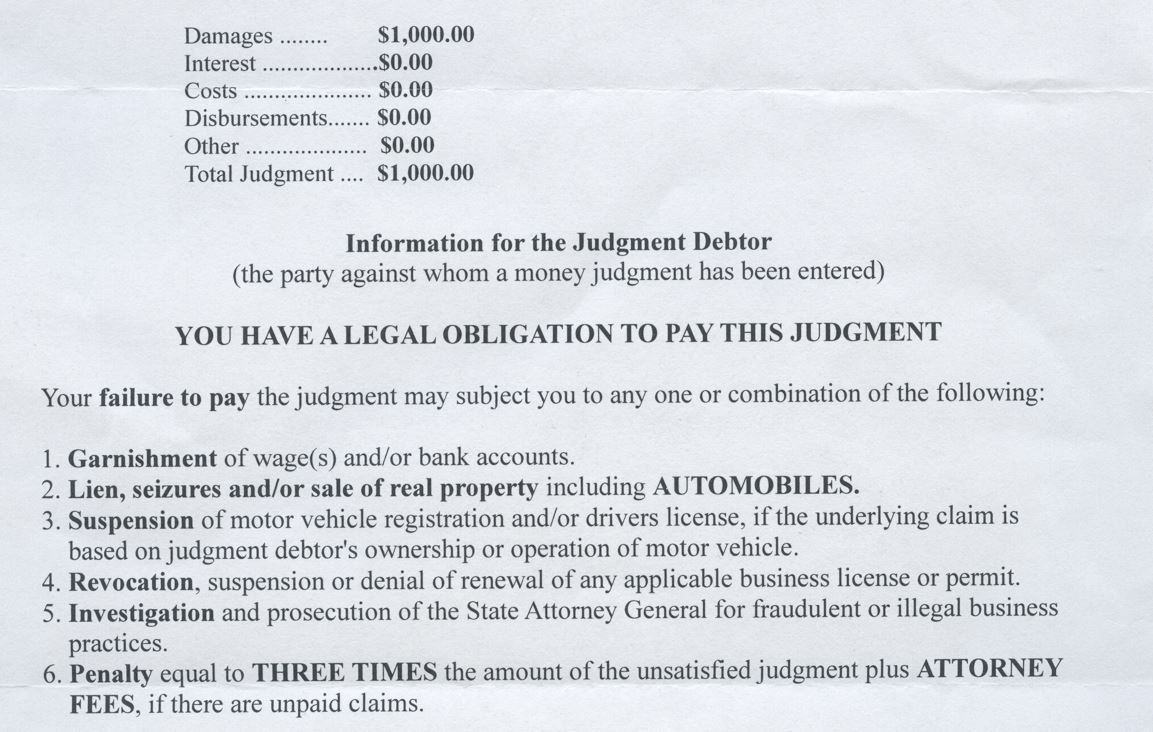
Post Court Date
I was relieved and happy and thankful I was done with this part of my life. I realized I had wasted so much time preparing my huge document, but the alternative of not being prepared wasn’t really an option. It was around early May that I received the judgment letter in the mail, it brought a huge smile to my face knowing Alec was receiving the same letter. The letter itself is intimidating stating in bold letters, “You have a legal obligation to pay this”.
I decided to give myself a break from dealing with this immature asshole and issue. I knew it might be an issue to get the money from the lodge, and so I figured I would wait a week or so before investigating.
Around the 10th I started investigating. There are services it seems you can go through which will help the process for a fee and whatnot. And in general you need to get something from the court, which then goes to the sheriff. Then you can proceed in a number of ways between wage garnishment, or seizing money from the bank, etc. The seizing money from the bank was what I figured I would do — as I had the bank account information from the first payment. Even more of a reason to make sure that the first deposit is a check or wire transfer from the business itself.
Thankfully, all of this became mute. On May 16th, I received a wire transfer from Alec for the outstanding balance of $1,000. There was no note, no apology, nothing. It was then I could finally rid myself of this small, weak, uneducated non-paying scum.
Part 3 – Hindsight 20/20
We missed a lot of warning signs. In hindsight, they weren’t really things we missed so much as potentially ignored or at the very least gave the benefit of doubt to. And to be honest, I think this is the hardest aspect. While hindsight is 20/20, we always want to believe the best in someone and a potential project. No-one ever goes into a project thinking things are going to go sideways, or with the goal to end up hating each other. There were good intentions at the beginning (hopefully) from everyone involved. The best we can do is try and learn from our mistakes and also protect ourselves even more thoroughly next time.
Warning Signs
- Having a project coming in that was close to exactly what we wanted, should have put us on our guard, instead it lowered our defenses. This was the very first problem. Because we wanted this project scale/type/location — it meant we looked past so many of the following warning signs. We didn’t want to ruin the project we had hoped for.
- It took a little bit into the process, but we later found out that the investment group owns several hotels, all of the others are budget hotels such as Hampton Inns and Comfort Inns throughout the Pennsylvania area. This hotel was a complete departure from their normal hotel… This one was meant for people vacationing from the city, looking for a relaxing retreat while their other hotels primary business would be people being ‘forced’ to use them as sleepy travelers along the highway, and conference visitors.
- We should not have taken the working relationship on his end with quite as much confidence as we did. Alec was able to give us access, information, and we even saw him doing other minor renovation work himself. In business, you need to at least have some confidence that someone is telling the truth, especially when there is no reason to believe otherwise. It would be nearly impossible to validate his status as the main decision maker and controller of funds; but we should have attempted to get in writing from the other Owners that Alec was in charge, or to verify they did not want to speak with us.
- The lack of a clearly defined scope isn’t something we are strangers to. However, Alec was drastically over his head. He was someone who maybe used to be a manager, and now was trying to run a full scale hotel renovation all by himself. This should have given us more pause — however, we understood our role to be a preliminary one and helping him understand the lay of the land. After all, this is partly why you hire an Architect, to help guide you through this process.
- As this was an investor deck presentation that could very well be tossed out if the investors did not like what we were doing – so extremely low liability… and also given the extremely tight schedule, we proceeded without a formal written and signed contract. In lieu of a contract, we utilized our first invoice to detail out what the deliverables would be and contract terms. This note section stated it was a 50% deposit, that 50% was due upon presentation, etc. It should be noted that this invoice was a perfectly enforceable contract and it did work how we needed it to with the courts. However, to protect ourselves more, we will be preparing at the very least a one page document that details what will be prepared (see Note 6) along with payment terms.
- About 3 days after the funds cleared into our bank, we got a request from Alec that the investor group wanted to know, ‘what they were paying for’. This was confusing on our end as we clearly had a long conversation with Alec and agreed to do an investor deck for him. Thankfully for us, we shared a detailed list in email of what we would be showing in the presentation. This presentation list became crucial to our defense and was something that we should have done to memorialize the presentation regardless of whether it was requested from us or not. This piece of information would have been crucial to our defense if they did show up. In hindsight, what we believe was happening is the investors saw 3.5k leaving a bank account and freaked out – pretty pathetic.
- It’s not uncommon for other designers to be interviewed, in fact we encourage it to our clients. We don’t believe it is our job to convince a client that we are the right people for the job, rather, we present ourselves as who we are and our design ethos and let them decide. This decision can only be made after speaking with multiple firms/people. This should however have been a red flag that something may have been kept from us, or that the client was at least being untruthful with project aspects – like the schedule. To hear there was another designer was frustrating since it didn’t feel like a level playing field (best we understood — it was a decorator who worked on Hampton Inns for the owner in the past). If you go to a fine dining establishment, you can’t complain that the burger costs more and took longer to prepare than Burger Kings. This is what happened.
- Alec was someone who stumbled around from job to job, never finding a home. In fact, we knew him from when he literally worked for 2 weeks at a previous job before quitting over disagreements. It seems he was either wealthy from his parents, or purely set for life given his old age and no children. He thought of himself as someone who appreciates good design, but also that he could be a designer himself. Showing us his favorite projects and his personally renovated AirBnB, we pretended to feign interest, and instead we should have been more truthful. They were gaudy, uninspired, and tacky. It’s not critical that a client knows what good design is, but when they think of themselves as designers with good taste (that is in actuality very poor taste), it should at least begin to question whether they are the right client for you. Those who think they can do, often do not yield control in the end.
- No Note “9”
- The largest and most glaring issue should have been seeing the “renovations” that Alec was doing already to the hotel and the innkeeper lodge. The lodge had huge issues, and he was painting it. The innkeeper house he was staying at also seemed to have structural issues… and he was painting it. The level of his renovation was quite literally ‘paint the problem away’. We should have known that he, and the investors, did not want to actually fix any real problems in a structural or costly way, but rather slap lipstick on a pig and hope they could charge more money. This was evident later by their real “renovations”.
- The actual video call was rude and unprofessional from the client side. Owners Morgan and Henry only asked one question at the beginning, and that was whether we had ‘chain hotel experience’. A question that makes some sense if you understand brands like Hilton and their design books that they follow for each hotel line and whatnot. However, the lodge was not a branded hotel. After briefly mentioning our experience working on Ace Hotels, Four Seasons, Marriott, and alike (all good/higher end chains)… the only rebuttal was, “‘”so you have no Hampton Inn experience?”. A laughable question. Regardless, we gave the presentation —what else were we going to do in that moment? During which we watched the main owner Morgan lose interest throughout – especially when we came to the budget slide estimating $2+ million for proper renovations. Henry we could tell was impressed and enjoying the presentation — even thanking us at the end; but as the son of the founder, you don’t disagree with daddy.
- Well here it is. There was another “designer” in the mix still. Honestly, this doesn’t bother us, we’ve competed for work before and will compete for work again. We also don’t change how much we prepare or how we prepare based on whether we think we are competing against someone else. The part that upset us was that through our following conversations, it was clear that the other “designer” was a decorator. This person has presumably little to no formal training evidence by the hotels upgrades, and is not a licensed Architect or office providing holistic solutions. For us, this was akin to them eating at a fast food restaurant, then coming to our sit down restaurant… and then wondering why it took our burger longer and cost more to cook. It was clear these owners have no idea what a real interior designer, or architecture office does, and furthermore were not interested in paying for real solutions (see note J)
- Funny enough, we do actually have an email with deliverables promised – thanks to you Alec. We were so thankful for this email at this point in time, and called out each PDF page number that the deliverable item corresponds to — which we did.
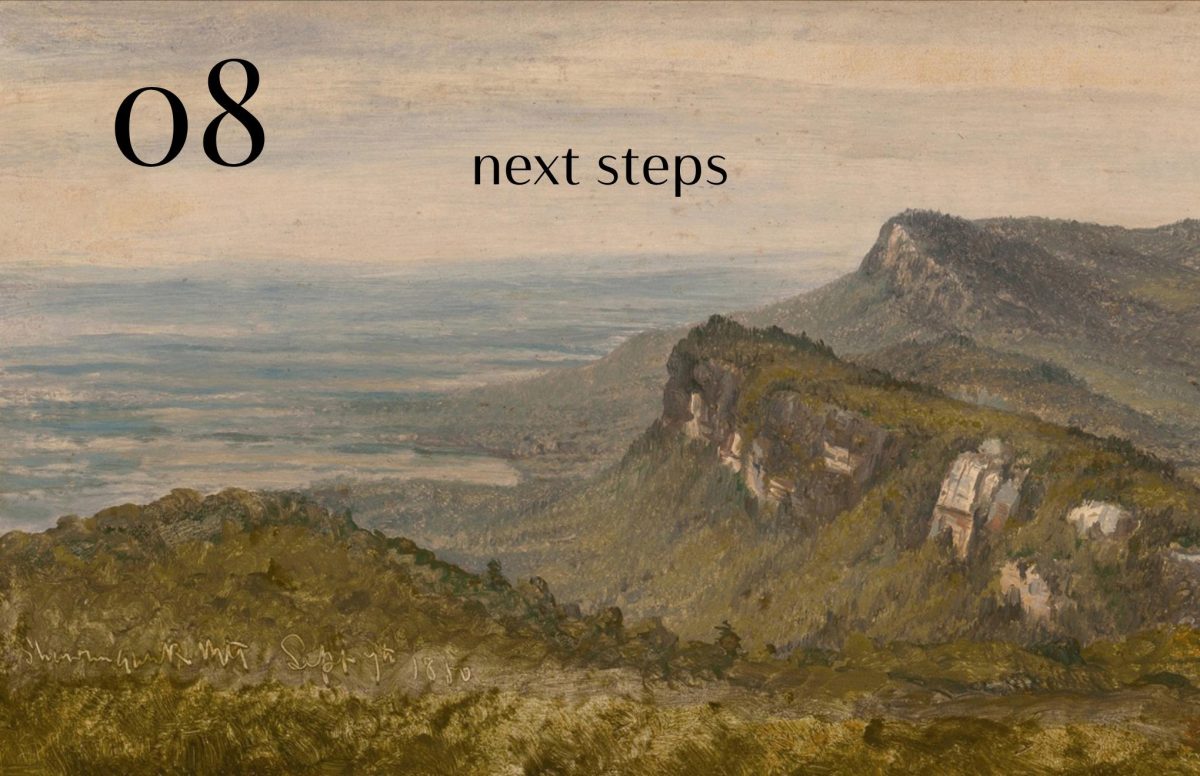
Part 4 – Conclusion
Their “Renovations”
They ended up going ahead with the other “designer”. To be honest, we aren’t even sure if that other designer was paid for work beyond their initial presentation — we would assume not. Industry friends have shared their social media posts highlighting the work they are doing as it is being done. It’s similar to what we came to realize… They are painting a couple walls, buying cheap particle board furniture, putting up some bead board and replacing a couple lights. They have not fixed any of the structural or big issues in the hotel like the sound, amenities, or anything else we holistically approached. The all in budget that they must be looking at has to be somewhere around $50k. In our professional opinion, running numbers on STC fixes, speaking with estimators and GCs, we came to a $1.6 to 2.8 million number.
They get what they paid for. The design already looks outdated and isn’t very good to begin with. Furniture will show signs of wear within a couple months, and the issues like sound and amenity offerings, etc… will all still persist and continue to turn away customers. One day it will matter. For now they are living on the benefit of being in an underserved area where ‘any’ hotel does well.
Final Thoughts
It’s clear now that we were not the right office for the job. We are playing on a whole different level of game than they wanted, and especially what they were willing to pay for. I laugh thinking back to the owners listening to my STC talk in the presentation, showing them architectural details and speaking about strategies like Resilient Channel Clips.
The solutions they were looking for was, ‘paint this wall blue, change that light bulb, and use a thicker comforter’.
We’ve taken a lot of lessons from this project, and still are hoping to learn more yet. We are going to be a bit more careful with our contracts, research a client a bit more thoroughly, and make sure that we are choosing the clients best we can; not just the clients choosing us. In the end, we aren’t entirely sure who we are mad at the most, or whether to just feel sad for them.
We are designers who love to build. We want to improve the world. This investor group is planning on sucking all the money they can out of this pig, and they have either misled Alec, or Alec misled us. Either way, we are so grateful we found this out so soon and that the project was short. We got our money, and can steer far away from this location, people, and project forever.


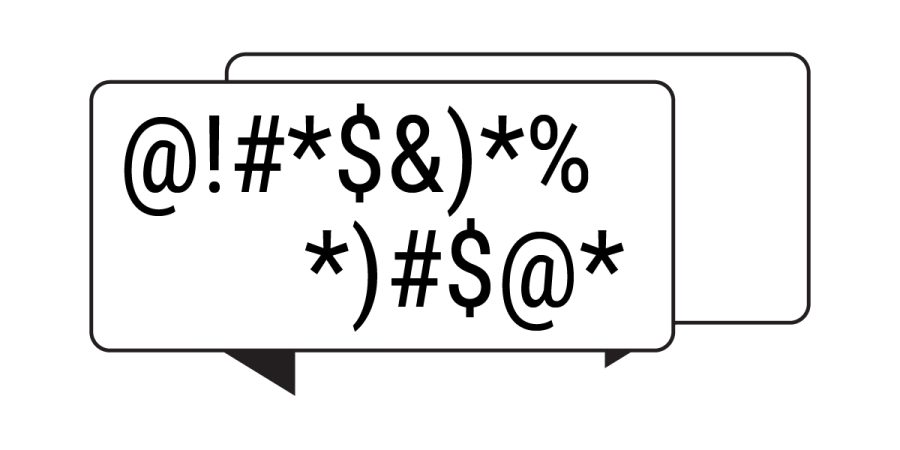

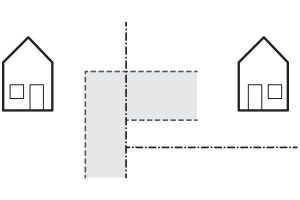
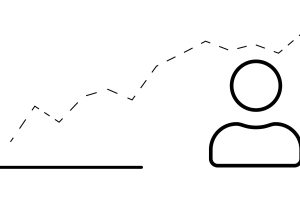
Leave a Reply
You must be logged in to post a comment.